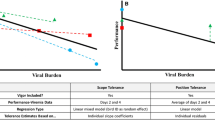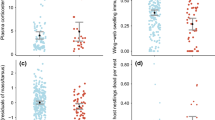Abstract
When introduced into new regions, invading organisms leave many native pathogens behind and also encounter evolutionarily novel disease threats. In the presence of predominantly novel pathogens that have not co-evolved to avoid inducing a strong host immune response, costly and potentially dangerous defenses such as the systemic inflammatory response could become more harmful than protective to the host. We therefore hypothesized that introduced populations exhibiting dampened inflammatory responses will tend to be more invasive. To provide initial data to assess this hypothesis, we measured metabolic, locomotor, and reproductive responses to inflammatory challenges in North American populations of the highly invasive house sparrow (Passer domesticus) and its less-invasive relative, the tree sparrow (Passer montanus). In the house sparrow, there was no effect of phytohemagglutinin (PHA) challenge on metabolic rate, and there were no detectable differences in locomotor activity between lipopolysaccharide (LPS)-injected birds and saline-injected controls. In contrast, tree sparrows injected with PHA had metabolic rates 20–25% lower than controls, and LPS injection resulted in a 35% drop in locomotor activity. In a common garden captive breeding experiment, there was no effect of killed-bacteria injections on reproduction in the house sparrow, while tree sparrows challenged with bacteria decreased egg production by 40% compared to saline-injected controls. These results provide some of the first data correlating variation in immune defenses with invasion success in introduced-vertebrate populations.



Similar content being viewed by others
References
Adler KL, Peng PH, Peng RK, Klasing KC (2001) The kinetics of hemopexin and alpha 1-acid glycoprotein levels induced by injection of inflammatory agents in chickens. Avian Dis 45:289–296
Anderson TR (1978) Population studies of European Sparrows in North America Occasional Papers of the Museum of Natural History. University of Kansas 70:1–58
Bonneaud C et al (2003) Assessing the cost of mounting an immune response. Amer Nat 161:367–379
Cooper WE (1999) Supplementation of phylogenetically correct data by two-species comparison: support for correlated evolution of foraging mode and prey chemical discrimination in lizards extended by first intrageneric evidence. Oikos 87:97–104
Cornell HV, Hawkins BA (1993) Accumulation of native parasitoid species on introduced herbivores—a comparison of hosts as natives and hosts as invaders. Amer Nat 141:847–865
Duncan RP, Blackburn TM, Veltman CJ (1999) Determinants of geographical range sizes: a test using introduced New Zealand birds. J Anim Ecol 68:963–975
Ghalambor CK, Martin TE (2000) Parental investment strategies in two species of nuthatch vary with stage-specific predation risk and reproductive effort. Anim Behav 60:263–267
Glowka L, Burhenne-Guilmin F, Synge H (1994) A guide to the convention on biological diversity. IUCN, Gland
Grasman KA (2002) Assessing immunological function in toxicological studies of avian wildlife. Integr Comp Biol 42:34–42
Greenman C, Martin L, Hau M (2005) Reproductive state, but not testosterone, reduces immune function in male house sparrows (Passer domesticus). Physiol Biochem Zool 78(1):60–68
Gurevitch J, Padilla DK (2004) Are invasive species a major cause of extinctions? Trends Ecol Evol 19:470–474
Holt PS (1993) Effect of induced molting on the susceptibility of white leghorn hens to a Salmonella enteritidis infection. Avian Dis 37:412–417
Hudson PJ, Dobson AP, Newborn D (1998) Prevention of population cycles by parasite removal. Science 282:2256–2258
Johnson RW, Curtis SE, Dantzer R, Bahr JM, Kelley KW (1993) Sickness behavior in birds caused by peripheral or central injection of endotoxin. Physiol Behav 53:343–348
Johnson LC, Bilgili SF, Hoerr FJ, McMurtrey BL, Norton RA (2001) The effects of early exposure of cellulitis-associated Escherichia coli in 1-day-old broiler chickens. Avian Pathol 30:175–178
Kendra PE, Roth RR, Tallamy DW (1988) Conspecific brood parasitism in the house sparrow. Wilson Bull 100:80–90
Kennedy CR, Pojmanska T (1996) Richness and diversity of helminth parasite communities in the common carp and in three more recently introduced carp species. J Fish Biol 48:89–100
Klasing KC (1998) Avian macrophages: regulators of local and systemic immune responses. Poult Sci 77:983–989
Klasing KC, Leshchinsky TV (1999) Functions, costs, and benefits of the immune system during development and growth. In: International Ornithol Congress, Proceedings, pp 2817–2832
Klein SL, Hairston JE, DeVries AC, Nelson RJ (1997) Social environment and steroid hormones affect species and sex differences in immune function among voles. Horm Behav 32:30–39
Kolar CS, Lodge DM (2001) Progress in invasion biology: predicting invaders. Trends Ecol Evol 16:199–204
Lee KA, Klasing KC (2004) A role for immunology in invasion biology. Trends Ecol Evol 19:523–529
Long JL (1981) Introduced birds of the world: the worldwide history, distribution, and influence of birds introduced to new environments. Terrey Hills, Sydney
Lowther PE, Cink CL (1992) House sparrow. Birds Of North America, Ithaca 12:1–19
Mack RN, Simberloff D, Lonsdale WM, Evans H, Clout M, Bazzaz FA (2000) Biotic invasions: causes, epidemiology, global consequences, and control. Ecol Appl 10:689–710
Mansfield JM, Olivier M (2002) Immune evasion by parasites. In: Kaufmann SHE, Sher A, Ahmed R (eds) Immunology of infectious diseases. ASM Press, Washington, pp 379–392
Martin TE, Martin PR, Olson CR, Heidinger BJ, Fontaine JJ (2000) Parental care and clutch sizes in North and South American birds. Science 287:1482–1485
Martin LB, Scheuerlein A, Wikelski M (2003) Immune activity elevates energy expenditure of house sparrows: a link between direct and indirect costs? Proc R Soc Lond B Biol Sci 270:153–158
Martin LB, Pless M, Svoboda J, Wikelski M (2004) Immune activity in temperate and tropical house sparrows: a common garden experiment. Ecology 85:2323–2331
McCorkle F, Olah I, Glick B (1980) Morphology of the phytohemagglutinin-induced cell response in the chickens wattle. Poult Sci 59:616–623
Mims C, Nash A, Stephen J (2001) Mims’ pathogenesis of infectious disease, 5th edn. Academic, London
Mini Mitter Co I (1999) Vitalview. In, 3.1 edn
Mitchell CE, Power AG (2003) Release of invasive plants from fungal and viral pathogens. Nature 421:625–627
Moller AP, Cassey P (2004) On the relationship between T-cell mediated immunity in bird species and the establishment success of introduced populations. J Anim Ecol 73:1035–1042
Moller AP, Merino S, Brown CR, Robertson RJ (2001) Immune defense and host sociality: a comparative study of swallows and martins. Amer Nat 158:136–145
Muller-Scharer H, Schaffner U, Steinger T (2004) Evolution in invasive plants: implications for biological control. Trends Ecol Evol 19:417
Oconnor RJ (1986) Biological characteristics of invaders among bird species in Britain. Philos Trans R Soc Lond B Biol Sci 314:583–598
Ricciardi A, Neves RJ, Rasmussen JB (1998) Impending extinctions of North American freshwater mussels (Unionoida) following the zebra mussel (Dreissena polymorpha) invasion. J Anim Ecol 67:613–619
Rigaud T, Moret Y (2003) Differential phenoloxidase activity between native and invasive gammarids infected by local acanthocephalans: differential immunosuppression? Parasitology 127:571–577
Sakai AK et al (2001) The population biology of invasive species. Annu Rev Ecol Syst 32:305–332
Smits JE, Bortolotti GR, Tella JL (1999) Simplifying the phytohaemagglutinin skin-testing technique in studies of avian immunocompetence. Funct Ecol 13:567–572
SPSS I (1999) SPSS. In, 10.0 edn, Chicago, IL
Summers-Smith JD (1988) The sparrows. Poyser, Calton
Summers-Smith JD (1995) The tree sparrow. Summers-Smith JD, Guisborough
Torchin ME, Lafferty KD, Dobson AP, McKenzie VJ, Kuris AM (2003) Introduced species and their missing parasites. Nature 421:628–630
Wiles GJ, Bart J, Beck RE, Aguon CF (2003) Impacts of the brown tree snake: patterns of decline and species persistence in Guam’s avifauna. Conserv Biol 17:1350–1360
Withers PC (1977) Measurement of VO2, VCO2 and evaporative water-loss with a flow-through mask. J Appl Physiol 42:120–123
Acknowledgements
We thank Lisa Fitzgerald for help with bird care and data collection, Ross Adams for assistance in obtaining permits and locating netting sites, H. and B. Horn and M. Guimond for help in providing aviary space at the Stony Ford Center for Ecological Studies, and K. C. Klasing, P. Henri and L. Spinney for comments on the manuscript. This work was funded by the National Science Foundation (IRCEB) and the Pew Charitable Trusts award 2000-002558. The experiments reported here were approved by the Princeton University Institutional Animal Care Committee and were in accordance with NIH Guidelines for the Care and Use of Laboratory Animals.
Author information
Authors and Affiliations
Corresponding author
Additional information
Communicated by Carol Vleck
Rights and permissions
About this article
Cite this article
Lee, K.A., Martin, L.B. & Wikelski, M.C. Responding to inflammatory challenges is less costly for a successful avian invader, the house sparrow (Passer domesticus), than its less-invasive congener. Oecologia 145, 243–250 (2005). https://doi.org/10.1007/s00442-005-0113-5
Received:
Accepted:
Published:
Issue Date:
DOI: https://doi.org/10.1007/s00442-005-0113-5




